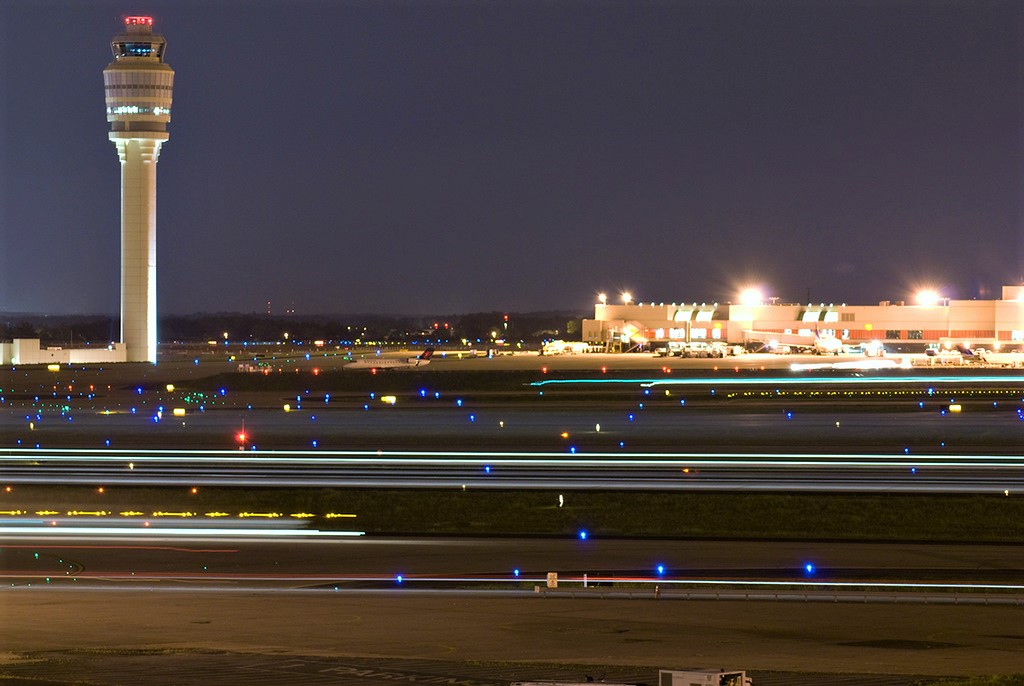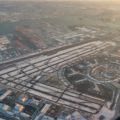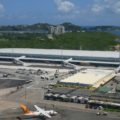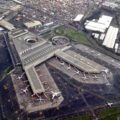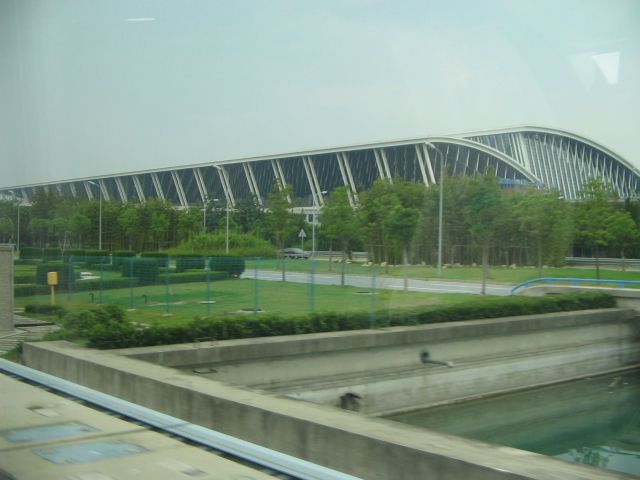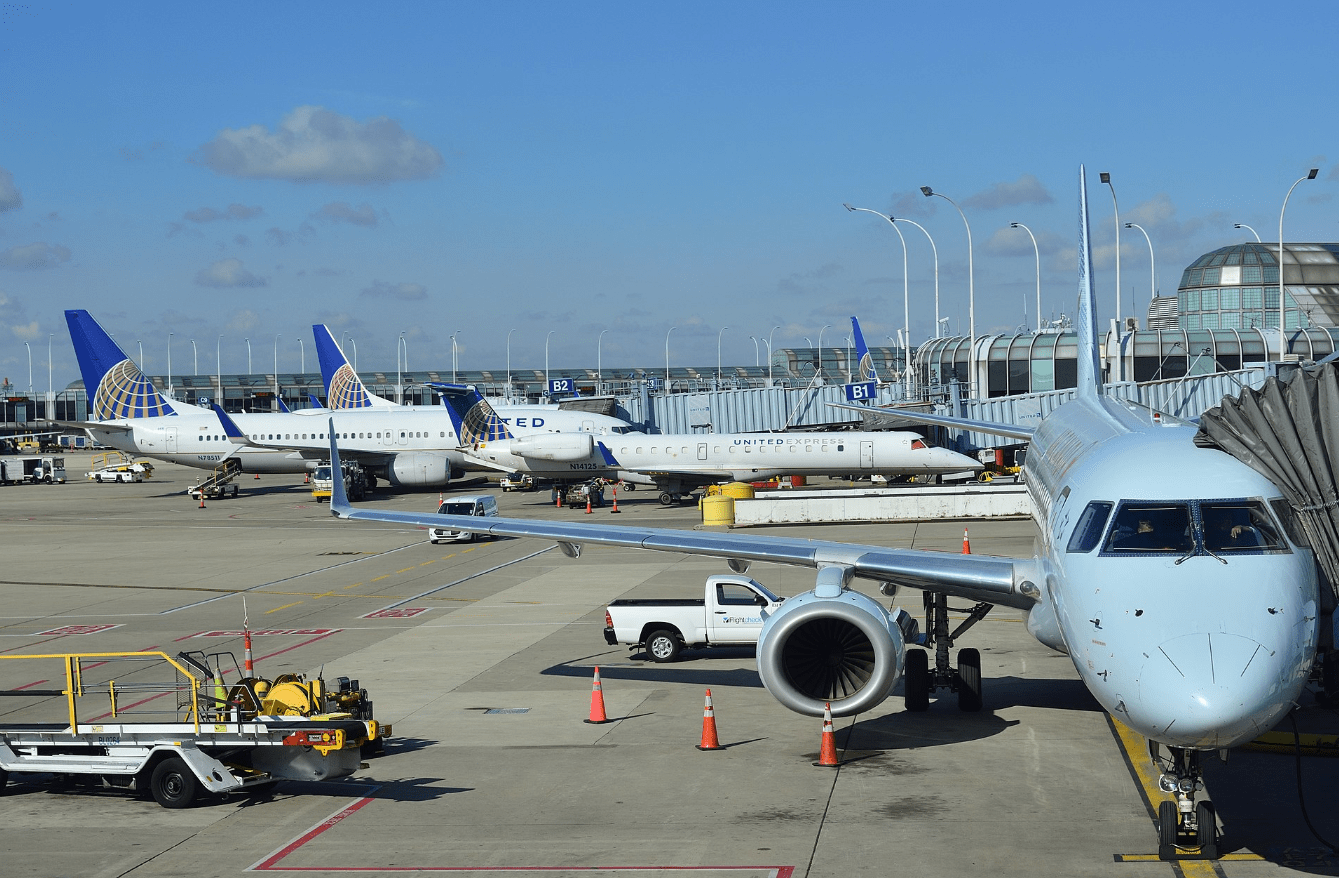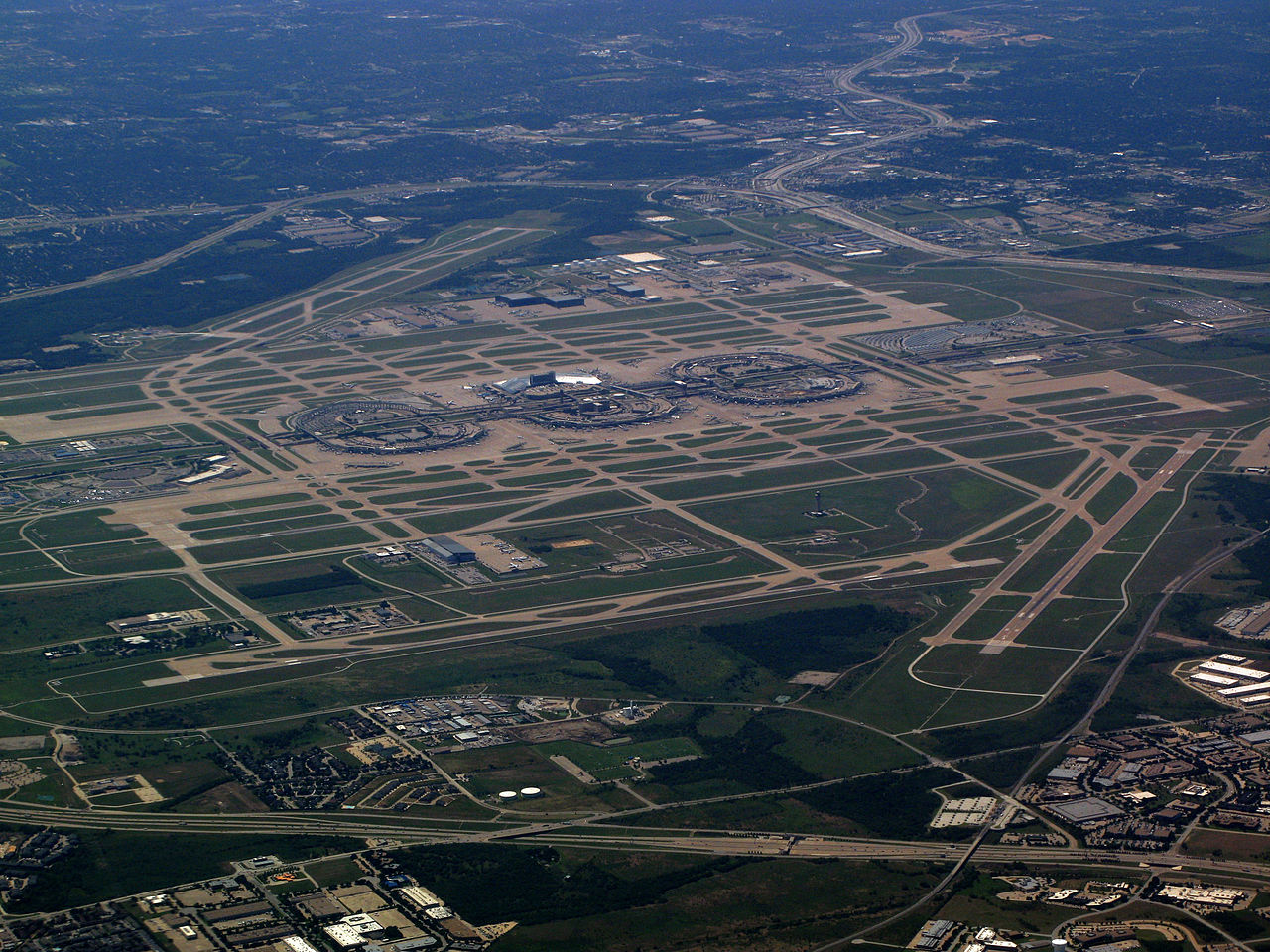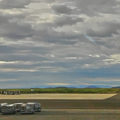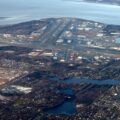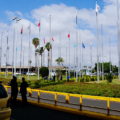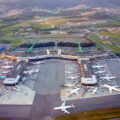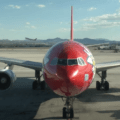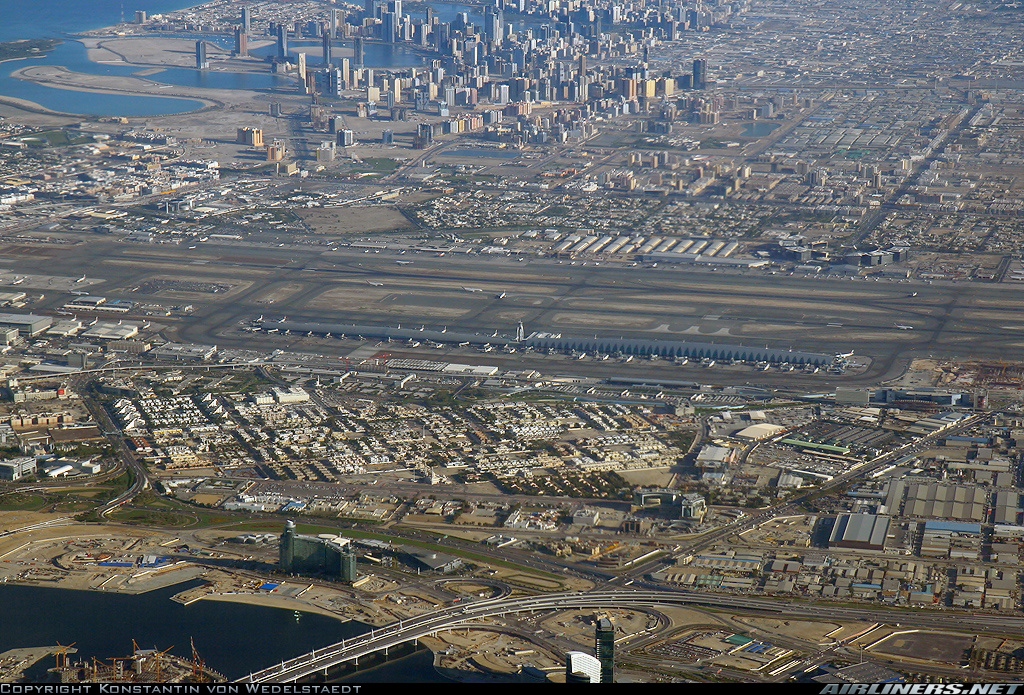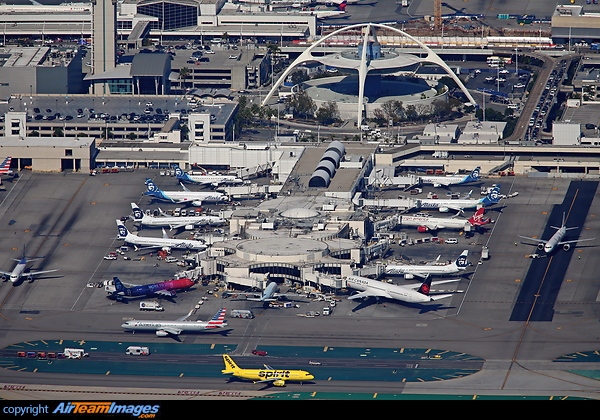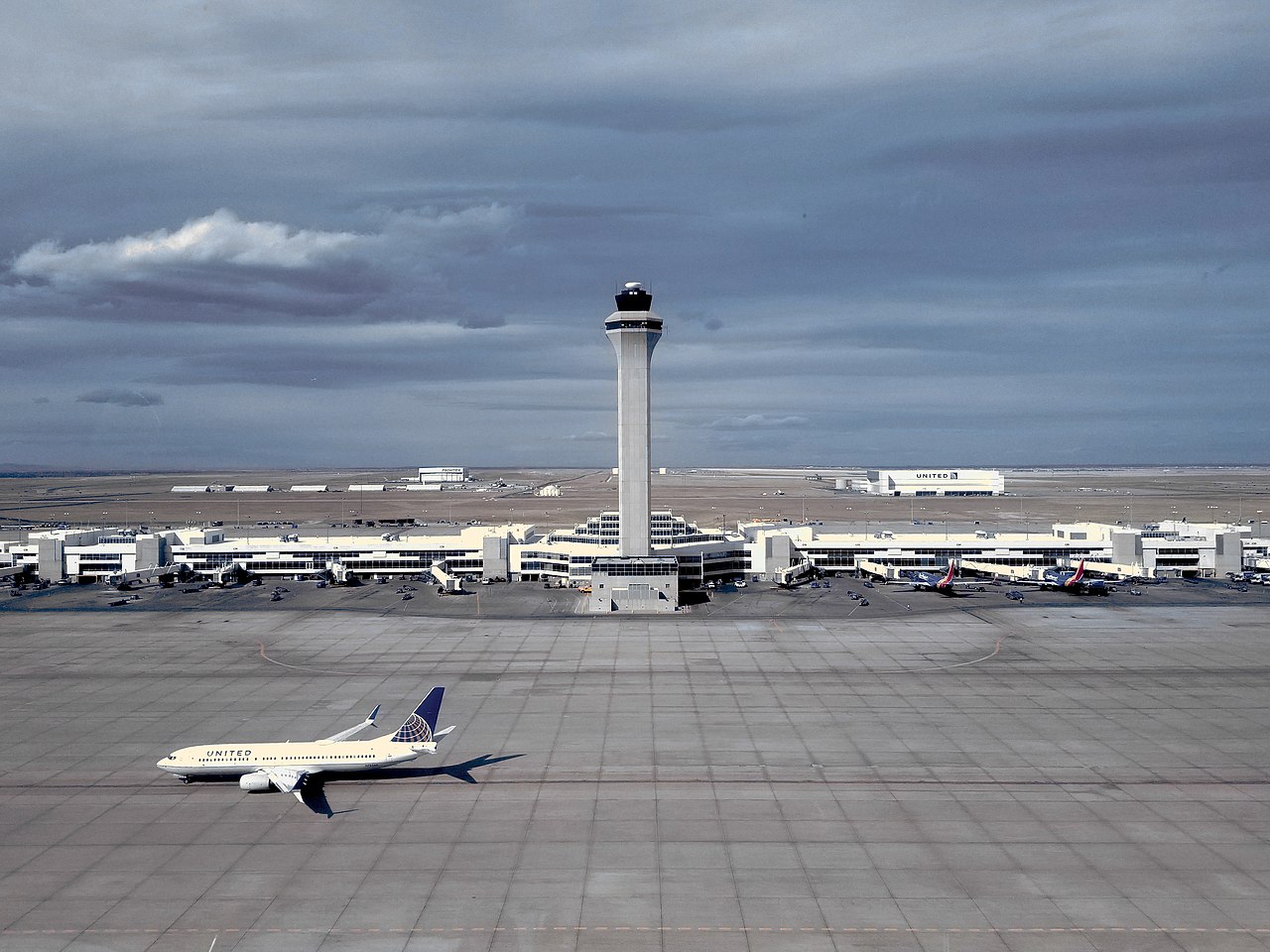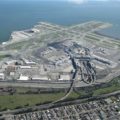Aviation
Las Vegas McCarran International Airport
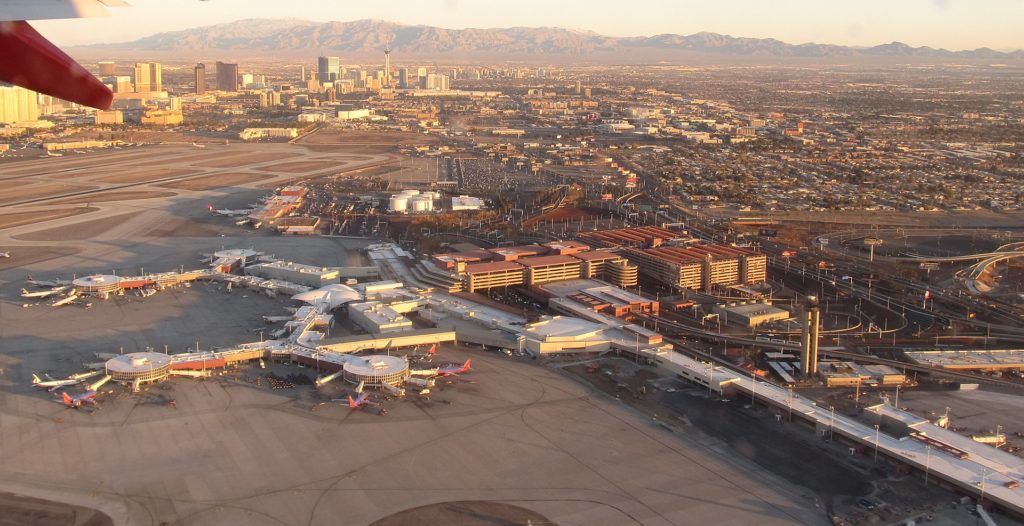
Source:: Ken Lund from Reno, Nevada, USA
| IATA: LAS ICAO: KLAS FAA LID: LAS WMO: 72386 | |
| Airport type | Public |
| Owner | Clark County |
| Operator | Clark County Department of Aviation |
| Serves | Las Vegas Valley, Southern Utah, Southern Nevada, Northern Arizona |
| Location | Paradise, Nevada, United States |
| Focus city for | Allegiant Air Frontier Airlines JSX Southwest Airlines Spirit Airlines Sun Country Airlines |
| Elevation AMSL | 2,181 ft / 665 m |
| Coordinates | |
| Website | mccarran.com |
McCarran International Airport (IATA: LAS, ICAO: KLAS, FAA LID: LAS) is an international airport in Paradise, Nevada and is the main airport for public and military use in the Las Vegas Valley, a metropolitan area in the U.S. state of Nevada, about 5 miles (8.0 km) south of Downtown Las Vegas. The airport is owned by Clark County and operated by the Clark County Department of Aviation. It is named after the late U.S. Senator Pat McCarran, a member of the Democratic Party who contributed to the development of aviation both in Las Vegas and on a national scale. LAS covers 2,800 acres (11.3 km2) of land.
The airport was built in 1942 and opened to airline flights in 1948. It has expanded since then and has employed various innovative technologies, such as common-use facilities. The airport has four runways and two passenger terminals. East of the passenger terminals is the Marnell Air Cargo Center, and on the west side of the airport are fixed-base operators and helicopter companies. The airport services as a base for Allegiant Air, Frontier Airlines, Southwest Airlines, and Spirit Airlines. It is the busiest airport in the United States that does not operate as a hub for any of the three U.S mainline carriers.


Facilities
Runways


Source: Sunnya343


Source: McCarran International Airport
McCarran Airport has four runways:
| Runway | Length | Width | ILS | Notes |
|---|---|---|---|---|
| 1L/19R | 8,988 ft 2,740 m | 150 ft 46 m | 1L | ILS Category I, with DME |
| 1R/19L | 9,771 ft 2,978 m | 150 ft 46 m | — | |
| 8L/26R | 14,515 ft 4,424 m | 150 ft 46 m | 26R | ILS Category I, with DME Second longest civil runway in North America |
| 8R/26L | 10,525 ft 3,208 m | 150 ft 46 m | 26L | ILS Category I |
All runways have been resurfaced with concrete, a more durable material than the previous asphalt. In April 2016, 8L/26R was the last runway to be resurfaced; it is the longest at McCarran and serves a third of the airport’s traffic. Parallel to it is runway 8R/26L, which opened in 1991. On the western side of the airport are runways 1L/19R and 1R/19L. 1L/19R was a 5000-foot runway for light aircraft before it was widened and lengthened in 1997. Between the two sets of parallel runways was runway 14/32, which has been decommissioned.[a] Runways 8L/26R and 8R/26L were previously 7L/25R and 7R/25L. The runways were renumbered 8L/26R and 8R/26L in August 2017 due to a shift in direction of the Earth’s magnetic field.
Dry weather at McCarran allows operations under visual flying rules 99% of the time. During most of the year (about 56% of the time) the airport uses Visual Configuration 1: runways 19R and 26L for arrivals and 19L and 26R for departures. Airfield capacity in Configuration 1 is constrained by bordering military airspace, high terrain to the west, and an uphill departure from 26R. Because of the heat, 26R is favored over 19L for departures. When the winds shift in the winter (about 13% of the year), the airfield adopts Visual Configuration 3, which uses 01L and 26L for arrivals and 01L and 01R for departures. Marginal flying conditions adopt the same Configuration 1/Configuration 3 split based on the prevailing winds. In instrument weather, arrivals are preferred on 26L, and departures take off from 19L and 26R.
Terminals
There are two terminals at McCarran and 5 concourses with a total of 92 gates. Terminal 1 was completed in 1963, Terminal 2 was completed in 1986, and Terminal 3 was completed in 2012. Prior to the completion of Terminal 3, Terminal 2 handled international flights. After Terminal 3 was completed, Terminal 2 became redundant and it was demolished in 2016.
Terminal 1 opened on March 15, 1963, and was expanded between 1970 and 1974 with the current A and B Gates buildings.[10] Currently, Terminal 1 has four concourses, each of which is connected to a central pre-security area. Ticketing and baggage claim are located on Level 1 of this area. Level 2 houses the three security checkpoints, an esplanade with several retail outlets, and a USO lounge for military service members. West of the pre-security area are the A Gates and the B Gates, two Y-shaped concourses with circular ends. To the south are the C Gates, which can be accessed by the Green Line of the tram system. The satellite D Gates concourse, which opened in 1998, lies to the east and contains three lounges: the Centurion lounge for American Express card holders; the Club at LAS, which is available to all passengers at a fee; and the United Club. The Blue Line of the tram system links the D Gates with the pre-security area. Gate D22 is the only 3-jetway gate at McCarran and was reconfigured specifically to accommodate the double-decker Airbus A380.
Terminal 3 handles all international and some domestic flights. Level 0 of the terminal contains customs, baggage claim, and another USO lounge. Check-in, security, a second Club at LAS, and all gates are on Level 2. The terminal has 14 gates, seven domestic (E8–E12, E14–E15) and the other seven international (E1–E7). Four of the international gates have two jetways each to allow for quicker handling of wide-body aircraft. Passengers flying Air Canada, Frontier Airlines, Hawaiian Airlines, Sun Country Airlines, and United Airlines all check-in and receive baggage at Terminal 3, but depart out of the D gates. The Red Line of the tram system links Terminal 3 with the D Gates.
Automated people mover
McCarran has three separate tram lines:
- Green line, connecting Terminal 1 with C Gates
- Blue line, connecting Terminal 1 with D Gates
- Red line, connecting Terminal 3 with D Gates
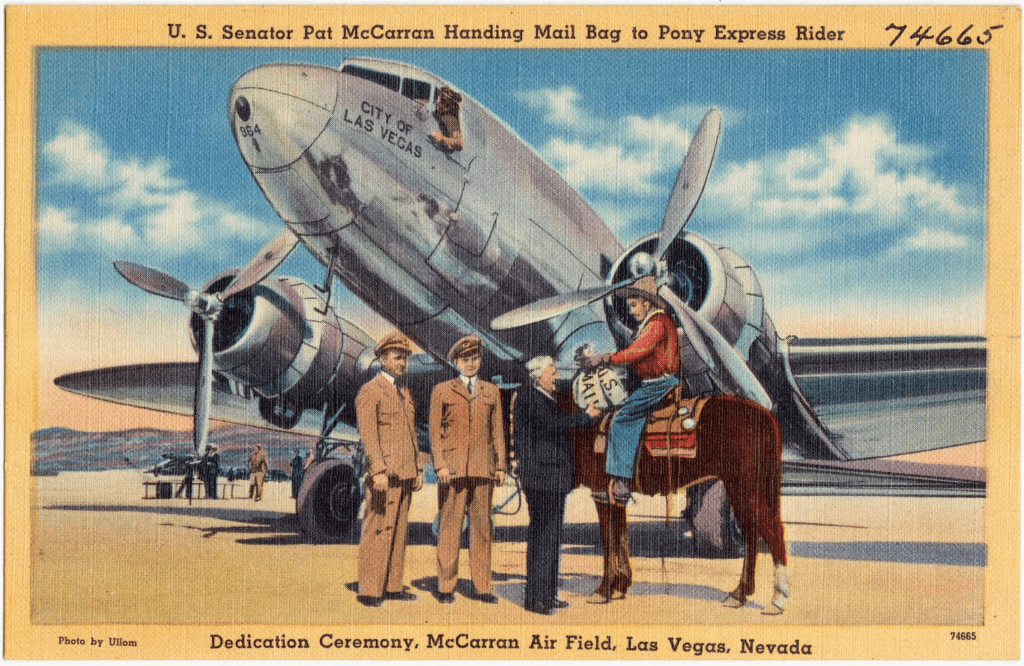

Source: Boston Public Library Tichnor Brothers collection #74665
Ground transportation


for the rental car center in 2010
Source: Go to Rent A Car Center
Road access to McCarran Airport is provided by Paradise Road to the north and by the McCarran Airport Connector to the south, which connects to the Las Vegas Beltway.
Terminal 1 and Terminal 3 have their own parking garages. Each also has its own economy lot, which provides lower parking rates, and a separate lot for oversize vehicles. Complimentary shuttle transportation is provided between the terminals and the remote Terminal 1 economy and oversize vehicle lots. In March 2016, the airport opened a cellphone lot, which provides free parking to people waiting for passengers.
A consolidated rental car facility opened in April 2007, located about 3 miles (4.8 km) from the airport. The facility, which sits on 68 acres (28 ha) of land, houses multiple rental car companies with 5,000 parking spaces on multiple levels. Courtesy shuttles transport passengers between the airport and the facility.
For transportation between Terminal 1 and Terminal 3, McCarran Airport provides a free shuttle service, which leaves from Level 0 of both terminals.
RTC Transit provides bus transportation to and from various parts of the Las Vegas Valley. Route 108, Route 109, the Westcliff Airport Express and the Centennial Express provide direct access to the airport. Buses depart from Level 0 of Terminal 1 and Level 2 of Terminal 3.
Other facilities
A small parking lot on the south side of the airport, on E. Sunset Road, between Las Vegas Blvd., and S. Eastern Ave, allows the public to watch aircraft take off, land, and listen to the aircraft radios. This is the only “official” watching area. There are several unofficial areas, mainly off the ends of the runways, however they are heavily patrolled by Las Vegas Metro Police and spectators are commonly asked to leave.
Atlantic Aviation and Signature Flight Support are the two fixed-base operators (FBOs) at the airport, providing various services to private aircraft.
Maverick Helicopters, Sundance Helicopters, and Papillon Grand Canyon Helicopters each operate their own terminal at McCarran Airport. The Maverick terminal covers 6,000 square feet (560 m2), while the Sundance terminal occupies 13,000 square feet (1,200 m2). The Papillon terminal was established in 1997. The companies provide helicopter tours over the Las Vegas Strip, Grand Canyon, and other tourist attractions.
Janet flights depart from a private terminal located on the west side of the airport. The airline, which is owned by the U.S. Air Force and operated by AECOM, transports employees and contractors to airports within the Nevada National Security Site.
The Marnell Air Cargo Center covers 200,928 square feet (18,666.8 m2) and can handle 100,000 short tons (91,000 t) of cargo. The $29 million facility opened in October 2010, replacing a smaller facility that existed at the site of Terminal 3. The center consists of two buildings, one of which is leased by FedEx and the other by multiple other companies, including UPS and Southwest Airlines.
The main exhibits of the Howard W. Cannon Aviation Museum are located on Level 2 of Terminal 1, above baggage claim. There are additional exhibits throughout the airport and at other airports in the city. Display items chronicle the early history of aviation in Southern Nevada. The museum is named after former Nevada Senator Howard Cannon, who contributed to the development of aviation in the county. Its administrator is Mark Hall-Patton, who has appeared on the reality television show Pawn Stars.
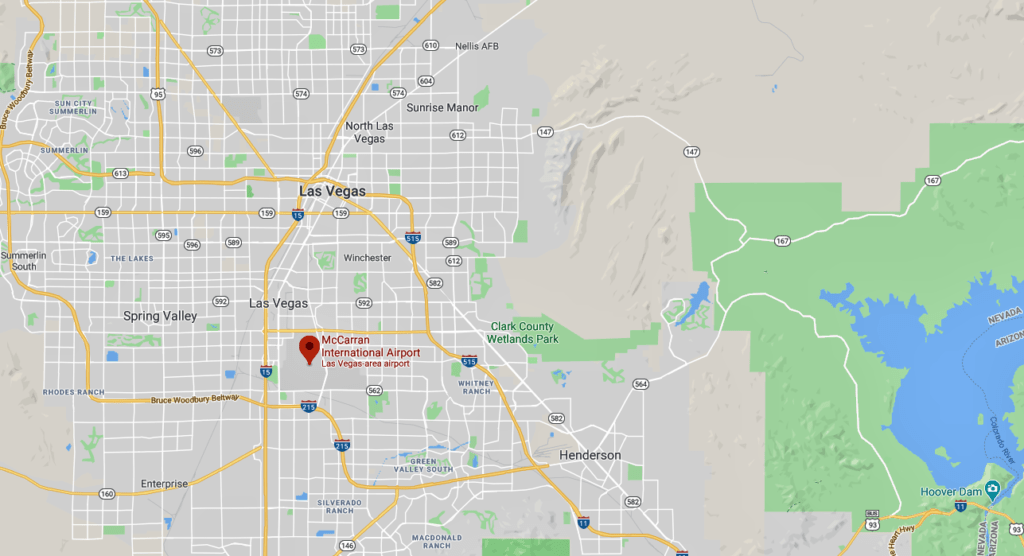

Airlines and destinations
Passenger
| Airlines | Destinations | Refs |
|---|---|---|
| Aeroméxico | Mexico City | |
| Aeroméxico Connect | Monterrey | |
| Air Canada Rouge | Calgary, Montréal–Trudeau, Toronto–Pearson, Vancouver | |
| Alaska Airlines | Everett, Los Angeles, Portland (OR), San Francisco, Seattle/Tacoma | |
| Allegiant Air | Albuquerque, Appleton, Austin, Belleville/St. Louis, Bellingham, Billings, Bismarck, Boise, Bozeman, Cedar Rapids/Iowa City, Chicago–Rockford, Cincinnati, Des Moines, El Paso, Eugene, Fargo, Fayetteville/Bentonville, Fresno, Grand Forks, Grand Island, Grand Junction, Grand Rapids, Great Falls, Idaho Falls, Indianapolis, Kalispell, Knoxville, Laredo, Louisville, McAllen, Medford, Memphis, Minot, Missoula, Moline/Quad Cities, Monterey, Oakland, Oklahoma City, Omaha, Peoria, Phoenix/Mesa, Rapid City, Redmond (OR), Reno/Tahoe, San Antonio, Santa Maria (CA), Shreveport, Sioux Falls, South Bend, Springfield/Branson, Stockton, Tri-Cities (WA), Tulsa, Wichita Seasonal: Fort Wayne, Los Angeles, Montrose, San Diego, Tucson | |
| American Airlines | Charlotte, Chicago–O’Hare, Dallas/Fort Worth, Los Angeles, Miami, New York–JFK, Philadelphia, Phoenix–Sky Harbor, Washington–National | |
| British Airways | London–Gatwick, London–Heathrow | |
| Condor | Frankfurt | |
| Copa Airlines | Panama City–Tocumen | |
| Delta Air Lines | Atlanta, Boston, Cincinnati, Detroit, Los Angeles, Minneapolis/St. Paul, New York–JFK, Salt Lake City, Seattle/Tacoma Seasonal: Raleigh/Durham | |
| Delta Connection | Long Beach, Los Angeles, Orange County, Portland (OR), Salt Lake City, San Diego, San Jose (CA) | |
| Edelweiss Air | Seasonal: Zürich | |
| El Al | Tel Aviv | |
| Eurowings | Frankfurt | |
| Frontier Airlines | Atlanta, Austin, Charlotte, Chicago–O’Hare, Cincinnati, Cleveland, Colorado Springs, Dallas/Fort Worth, Denver, Detroit, Greenville/Spartanburg, Houston–Intercontinental, Indianapolis, Los Angeles, Madison, Miami, Milwaukee, Nashville, Newark, Norfolk, Omaha, Ontario (CA), Orange County, Orlando, Philadelphia, Phoenix–Sky Harbor, Portland (OR), Raleigh/Durham, Reno/Tahoe, Sacramento, St. Louis, Salt Lake City, San Antonio, San Diego, San Francisco, San Jose (CA), Seattle/Tacoma, Spokane, Tampa, Washington–Dulles | |
| Hawaiian Airlines | Honolulu, Kahului | |
| Interjet | Guadalajara, Mexico City, Monterrey | |
| JetBlue Airways | Boston, Fort Lauderdale, Long Beach, New York–JFK | |
| JSX | Burbank, Oakland, Orange County, Phoenix | |
| KLM | Amsterdam | |
| Korean Air | Seoul–Incheon | |
| Southwest Airlines | Albuquerque, Amarillo, Atlanta, Austin, Baltimore, Birmingham (AL), Boise, Buffalo, Burbank, Chicago–Midway, Cleveland, Columbus, Dallas–Love, Denver, Des Moines, Detroit, El Paso, Fort Lauderdale, Houston–Hobby, Indianapolis, Kansas City, Little Rock, Long Beach, Los Angeles, Louisville, Lubbock, Midland/Odessa, Milwaukee, Nashville, New Orleans, Oakland, Oklahoma City, Omaha, Ontario, Orange County, Orlando, Phoenix–Sky Harbor, Pittsburgh, Portland (OR), Raleigh/Durham, Reno/Tahoe, Sacramento, St. Louis, Salt Lake City, San Antonio, San Diego, San Francisco, San Jose (CA), Seattle/Tacoma, Spokane, Tampa, Tucson, Tulsa, Wichita Seasonal: Albany, Minneapolis/St. Paul, Philadelphia | |
| Spirit Airlines | Atlanta, Austin, Baltimore, Boston, Burbank, Chicago–O’Hare, Cleveland, Columbus, Dallas/Fort Worth, Denver, Detroit, Fort Lauderdale, Houston–Intercontinental, Indianapolis, Kansas City, Los Angeles, Minneapolis/St. Paul, Nashville, Newark, New Orleans, Oakland, Orlando, Philadelphia, Pittsburgh, Portland (OR), Sacramento, San Diego, Seattle/Tacoma, Tampa | |
| Sun Country Airlines | Dallas/Fort Worth, Minneapolis/St. Paul, Portland (OR) Seasonal: Los Angeles, Madison, Phoenix–Sky Harbor, San Antonio, St. Louis | |
| Swoop | Abbotsford, Edmonton, Hamilton (ON), Winnipeg Seasonal: Kelowna, London (ON) | |
| United Airlines | Chicago–O’Hare, Denver, Houston–Intercontinental, Los Angeles, Newark, San Francisco, Washington–Dulles | |
| United Express | Los Angeles, San Francisco | |
| Virgin Atlantic | London–Heathrow | |
| VivaAerobus | Mexico City Seasonal: Monterrey | |
| Volaris | Guadalajara, León/Del Bajío, Mexico City | |
| WestJet | Calgary, Edmonton, Toronto–Pearson, Vancouver, Winnipeg Seasonal: Regina, Saskatoon |
Cargo
Cargo airlines at McCarran:
- Aloha Air Cargo
- FedEx Express
- UPS Airlines
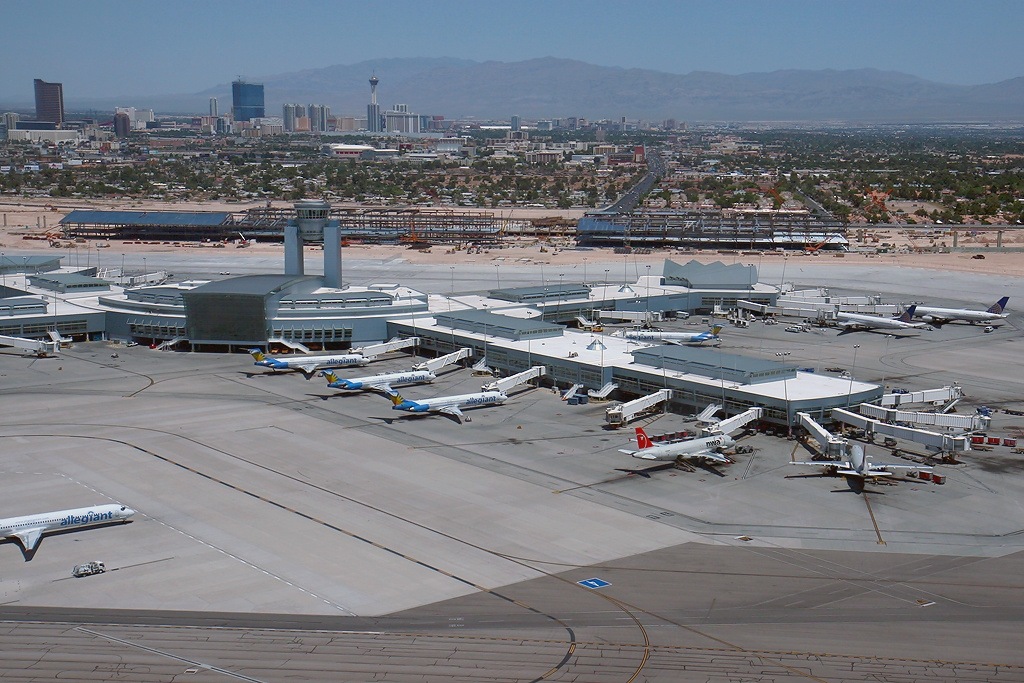

Source: Photo http://cdn-www.airliners.net/aviation-photos/photos/9/7/7/1531779.jpg
Accidents and incidents
- On the evening of November 15, 1964, Bonanza Air Lines Flight 114, a Fairchild F-27 turboprop flying from Phoenix Sky Harbor International Airport to McCarran Int’l Airport crashed into the top of a hill in desert country about 8 miles (13 km) SSW of Las Vegas in poor weather conditions, all 26 passengers and three crew perished. The probable cause was the misreading of a faulty, outdated approach chart by the captain which resulted in a premature descent before impacting terrain.
- On September 8, 2015, British Airways Flight 2276 aborted takeoff from McCarran due to engine failure. While preparing to takeoff from runway 7L for London Gatwick Airport, the Boeing 777-200ER suffered failure of its left (#1) engine, and a fire erupted. 14 passengers suffered injuries during the evacuation, and the runway was closed for eight hours. The aircraft suffered major damage, but it was repaired and returned to service in March 2016.
Ivanpah Valley Airport
In the late 1990s, the county decided to build a second airport for Las Vegas, to be located 30 miles (48 km) from the city in the Ivanpah Valley. Passenger traffic at McCarran had been rising steadily, and the county predicted that the airport would reach its capacity of 55 million passengers per year by 2008. The county began the process of acquiring federal land for the airport, and it started funding an EIS. However, the advent of an economic recession in 2007 and the resulting decline in passenger numbers called the Ivanpah Valley Airport project into question. In June 2010, the project was indefinitely suspended. However, the county continues to monitor the site of the planned airport, and it will reconsider the project once McCarran Airport reaches its capacity.
Source: wikipedia
